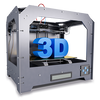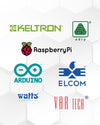
Know More About NodeMCU
Introduction to NodeMCU V3

NodeMCU V3 is an open-source firmware and development kit that plays a vital role in designing your own IoT product using a few Lua script lines.
Multiple GPIO pins on the board allow you to connect the board with other peripherals and are capable of generating PWM, I2C, SPI, and UART serial communications.
- The interface of the module is mainly divided into two parts including both Firmware and Hardware where former runs on the ESP8266 Wi-Fi SoC and later is based on the ESP-12 module.
The firmware is based on Lua – A scripting language that is easy to learn, giving a simple programming environment layered with a fast scripting language that connects you with a well-known developer community.
And open source firmware gives you the flexibility to edit, modify and rebuilt the existing module and keep changing the entire interface until you succeed in optimizing the module as per your requirements.
- USB to UART converter is added on the module that helps in converting USB data to UART data which mainly understands the language of serial communication.
Instead of the regular USB port, MicroUSB port is included in the module that connects it with the computer for dual purposes: programming and powering up the board.
- The board incorporates status LED that blinks and turns off immediately, giving you the current status of the module if it is running properly when connected with the computer.
The ability of the module to establish a flawless WiFi connection between two channels makes it an ideal choice for incorporating it with other embedded devices like Raspberry Pi.
NodeMCU V3 Pinout
NodeMCU V3 comes with a number of GPIO Pins. The following figure shows the Pinout of the board.

There is a candid difference between Vin and VU where former is the regulated voltage that may stand somewhere between 7 to 12 V while later is the power voltage for USB that must be kept around 5 V.
NodeMCU V3 Features
- Open-source
- Arduino-like hardware
- Status LED
- MicroUSB port
- Reset/Flash buttons
- Interactive and Programmable
- Low cost
- ESP8266 with inbuilt wifi
- USB to UART converter
- GPIO pins
As mentioned above, a cable supporting micro USB port is used to connect the board. As you connect the board with a computer, LED will flash. You may need some drivers to be installed on your computer if it fails to detect the NodeMCU board. You can download the driver from this page.
Note: We use Arduino IDE software for programming this module. It is important to note that the pin configuration appearing on the board is different from the configuration we use to program the board on the software i.e. when we write code for targeting pin 16 on the Arduino IDE, it will actually help is laying out the communication with the D0 pin on the module.
Following figure the shows the pin configuration to use in Arduino IDE.

How to Power NodeMCU V3?
You can see from the pinout image above, there are five ground pins and three 3V3 pins on the board. The board can be powered up using the following three ways.
USB Power. It proves to an ideal choice for loading programs unless the project you aim to design requires separate interface i.e. disconnected from the computer.
Provide 3.3V. This is another great option to power up the module. If you have your own off-board regulator, you can generate an instant power source for your development kit.
Power Vin. This is a voltage regulator that comes with the ability to support up to 800 mA. It can handle somewhere between 7 to 12 V. You cannot power the devices operating at 3.3 V, as this regulator unable to generate as low as 3.3V.
Projects and Applications
NodeMCU V3 is mainly used in the WiFi Applications which most of the other embedded modules fail to process unless incorporated with some external WiFi protocol. Following are some major applications used for NodeMCU V3.
- Internet Smoked Alarm
- VR Tracker
- Octopod
- Serial Port Monitor
- ESP Lamp
- Incubator Controller
- IoT home automation
- Security Alarms
That’s all for now. I hope I have given you something valuable related to this module. If you have any question, you can approach me in the comment section below. I’d love to help you the best way I can. You are most welcome to keep us updated with your valuable feedback so we keep producing quality content as per your needs and requirements. Thanks for reading the article.



